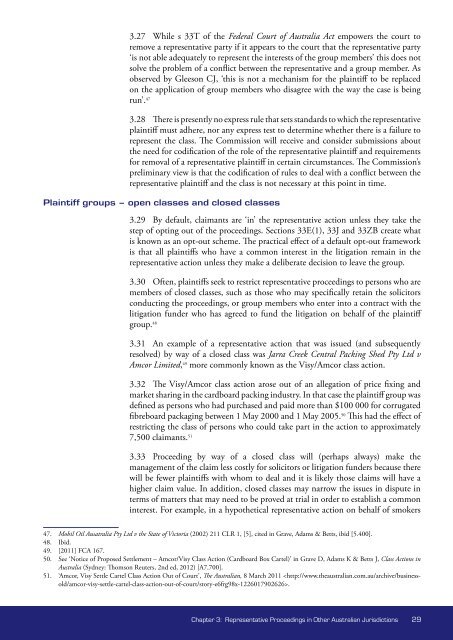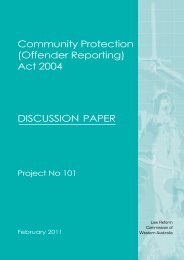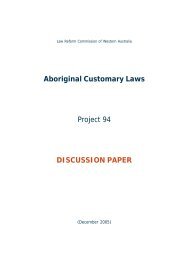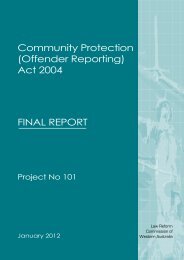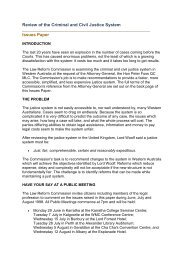Discussion Paper - Law Reform Commission of Western Australia
Discussion Paper - Law Reform Commission of Western Australia
Discussion Paper - Law Reform Commission of Western Australia
Create successful ePaper yourself
Turn your PDF publications into a flip-book with our unique Google optimized e-Paper software.
3.27 While s 33T <strong>of</strong> the Federal Court <strong>of</strong> <strong>Australia</strong> Act empowers the court to<br />
remove a representative party if it appears to the court that the representative party<br />
‘is not able adequately to represent the interests <strong>of</strong> the group members’ this does not<br />
solve the problem <strong>of</strong> a conflict between the representative and a group member. As<br />
observed by Gleeson CJ, ‘this is not a mechanism for the plaintiff to be replaced<br />
on the application <strong>of</strong> group members who disagree with the way the case is being<br />
run’. 47<br />
3.28 There is presently no express rule that sets standards to which the representative<br />
plaintiff must adhere, nor any express test to determine whether there is a failure to<br />
represent the class. The <strong>Commission</strong> will receive and consider submissions about<br />
the need for codification <strong>of</strong> the role <strong>of</strong> the representative plaintiff and requirements<br />
for removal <strong>of</strong> a representative plaintiff in certain circumstances. The <strong>Commission</strong>’s<br />
preliminary view is that the codification <strong>of</strong> rules to deal with a conflict between the<br />
representative plaintiff and the class is not necessary at this point in time.<br />
Plaintiff groups – open classes and closed classes<br />
3.29 By default, claimants are ‘in’ the representative action unless they take the<br />
step <strong>of</strong> opting out <strong>of</strong> the proceedings. Sections 33E(1), 33J and 33ZB create what<br />
is known as an opt-out scheme. The practical effect <strong>of</strong> a default opt-out framework<br />
is that all plaintiffs who have a common interest in the litigation remain in the<br />
representative action unless they make a deliberate decision to leave the group.<br />
3.30 Often, plaintiffs seek to restrict representative proceedings to persons who are<br />
members <strong>of</strong> closed classes, such as those who may specifically retain the solicitors<br />
conducting the proceedings, or group members who enter into a contract with the<br />
litigation funder who has agreed to fund the litigation on behalf <strong>of</strong> the plaintiff<br />
group. 48<br />
3.31 An example <strong>of</strong> a representative action that was issued (and subsequently<br />
resolved) by way <strong>of</strong> a closed class was Jarra Creek Central Packing Shed Pty Ltd v<br />
Amcor Limited, 49 more commonly known as the Visy/Amcor class action.<br />
3.32 The Visy/Amcor class action arose out <strong>of</strong> an allegation <strong>of</strong> price fixing and<br />
market sharing in the cardboard packing industry. In that case the plaintiff group was<br />
defined as persons who had purchased and paid more than $100 000 for corrugated<br />
fibreboard packaging between 1 May 2000 and 1 May 2005. 50 This had the effect <strong>of</strong><br />
restricting the class <strong>of</strong> persons who could take part in the action to approximately<br />
7,500 claimants. 51<br />
3.33 Proceeding by way <strong>of</strong> a closed class will (perhaps always) make the<br />
management <strong>of</strong> the claim less costly for solicitors or litigation funders because there<br />
will be fewer plaintiffs with whom to deal and it is likely those claims will have a<br />
higher claim value. In addition, closed classes may narrow the issues in dispute in<br />
terms <strong>of</strong> matters that may need to be proved at trial in order to establish a common<br />
interest. For example, in a hypothetical representative action on behalf <strong>of</strong> smokers<br />
47. Mobil Oil Ausatralia Pty Ltd v the State <strong>of</strong> Victoria (2002) 211 CLR 1, [5], cited in Grave, Adams & Betts, ibid [5.400].<br />
48. Ibid.<br />
49. [2011] FCA 167.<br />
50. See ‘Notice <strong>of</strong> Proposed Settlement – Amcor/Visy Class Action (Cardboard Box Cartel)’ in Grave D, Adams K & Betts J, Class Actions in<br />
<strong>Australia</strong> (Sydney: Thomson Reuters, 2nd ed, 2012) [A7.700].<br />
51. ‘Amcor, Visy Settle Cartel Class Action Out <strong>of</strong> Court’, The <strong>Australia</strong>n, 8 March 2011 .<br />
Chapter 3: Representative Proceedings in Other <strong>Australia</strong>n Jurisdictions 29


